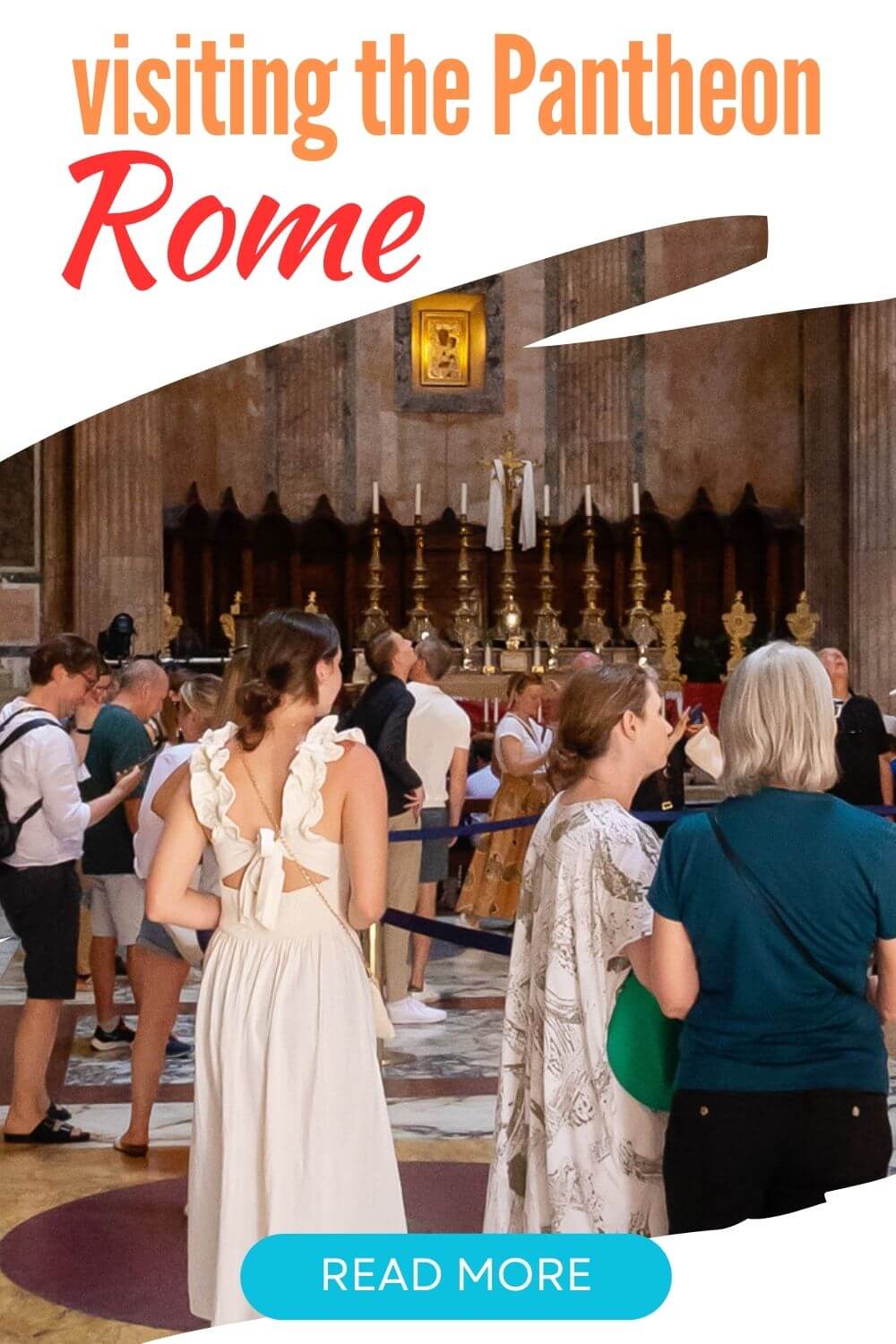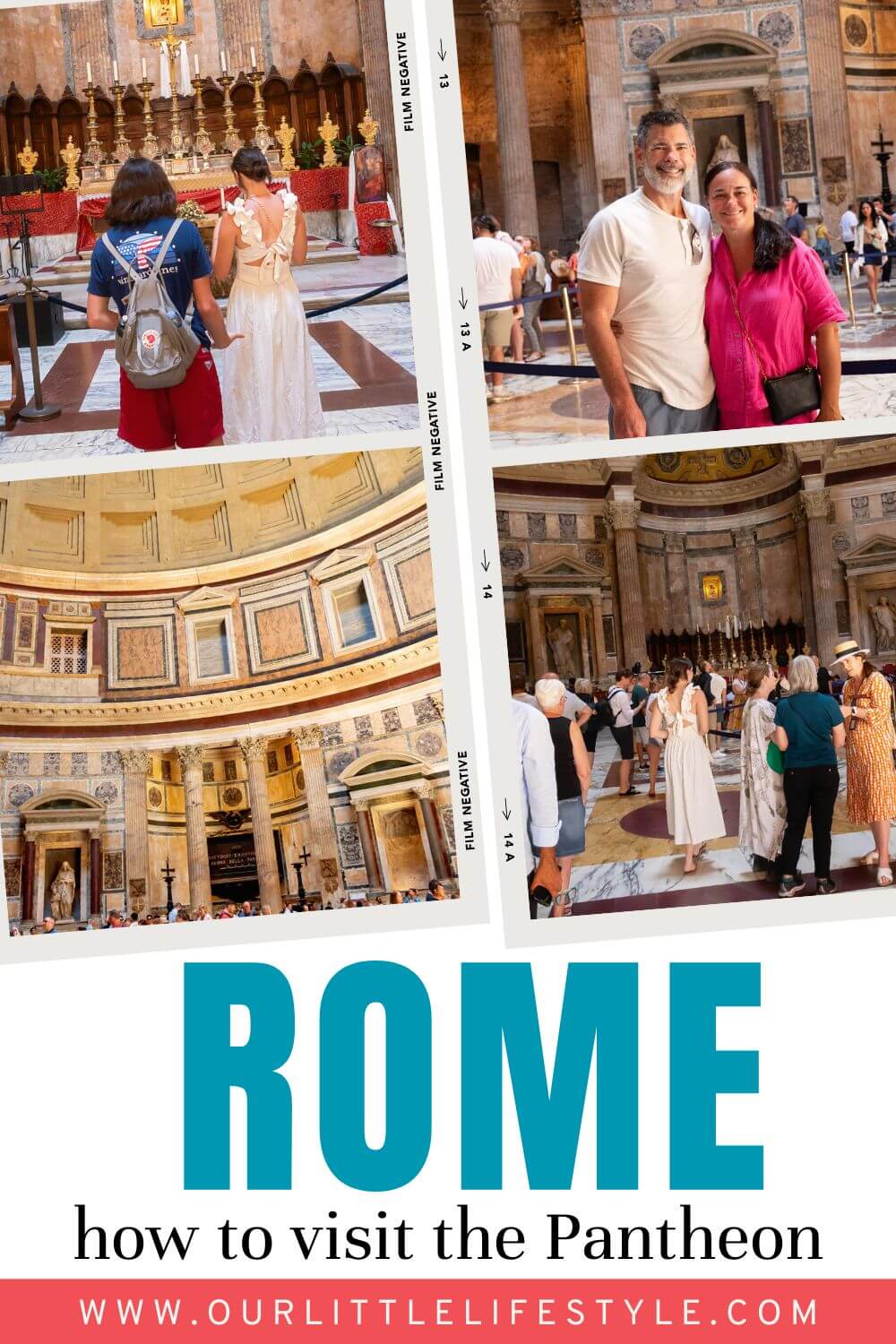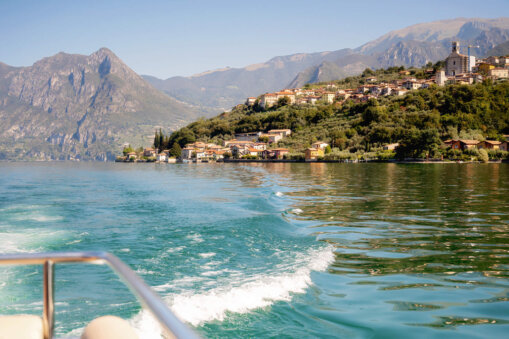We may earn money or products from the companies mentioned in this post. As an Amazon Associate, I earn from qualifying purchases.
We just got back from a fantastic 3-week trip to the French and Italian coasts, Rome, and Venice. It was an amazing way to see many well-known places and experience the beauty, hospitality, and food of these iconic locations. We spent five days in Rome this summer. While there, we got to see many of the bucket-list attractions like the Colosseum, the Roman Forum, and St. Peter’s Basilica. One of our absolute favorite experiences was visiting the Pantheon in Rome, Italy.
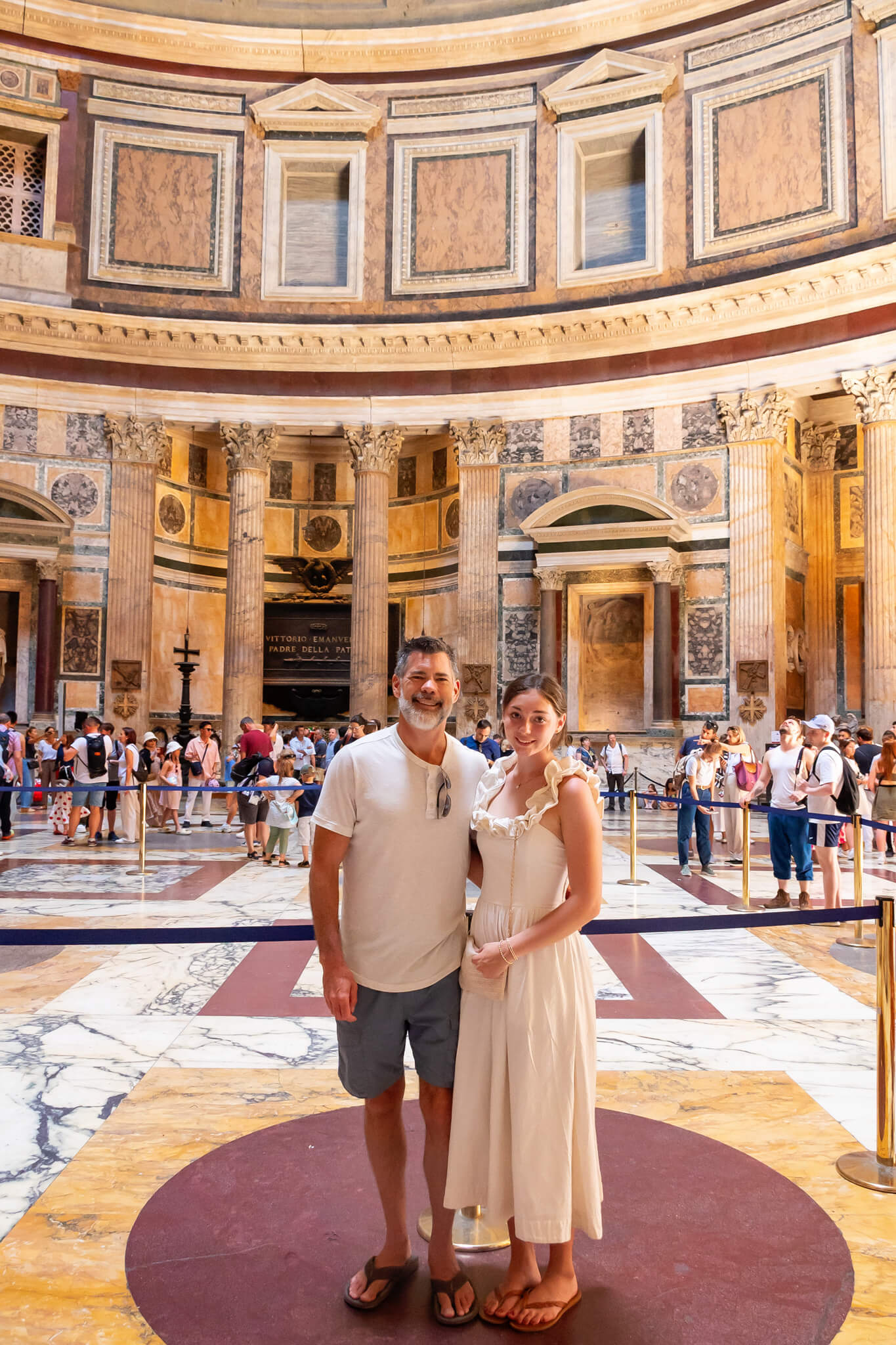
Visiting the Pantheon in Rome, Italy
There’s so much to see in Rome that it can be overwhelming, but there are a handful of landmarks you absolutely want to visit. These locations are ancient architectural and artistic masterpieces of the once-mighty Roman Empire.
That said, I do highly recommend you carve out time for visiting the Pantheon because of its proximity to other attractions, low ticket cost, and cultural and historical significance. It’s the perfect short Rome activity for a family looking for a 1-2 hour cultural experience that’s easily walkable and less taxing than some of the more spread-out and crowded sights.
In this post, I’ll share information about the Pantheon’s history and design and tips on how to make your visit as smooth as possible!
RELATED POST: How To Plan A Trip To Europe
Why Should You Visit The Pantheon?
Because it’s iconic! The Pantheon is one of the best-intact ancient Roman buildings in existence. Its massive scale, huge dome, and detailed artistry are excellent examples of the advanced construction skills of the Roman people. This architectural marvel is not just a testament to Roman engineering; it’s also a journey through time, from its origins as a pagan temple to its later role as a Christian church.
Visiting the Pantheon in Rome
Visiting the Roman Pantheon is less daunting than some of the other, larger, and more logistically complex sites like the Colosseum or the Vatican. The Pantheon is located in the heart of Rome, in a beautiful square called Piazza della Rotonda. It is situated in the center of a maze-like network of shop-laden cobbled streets and alleys.
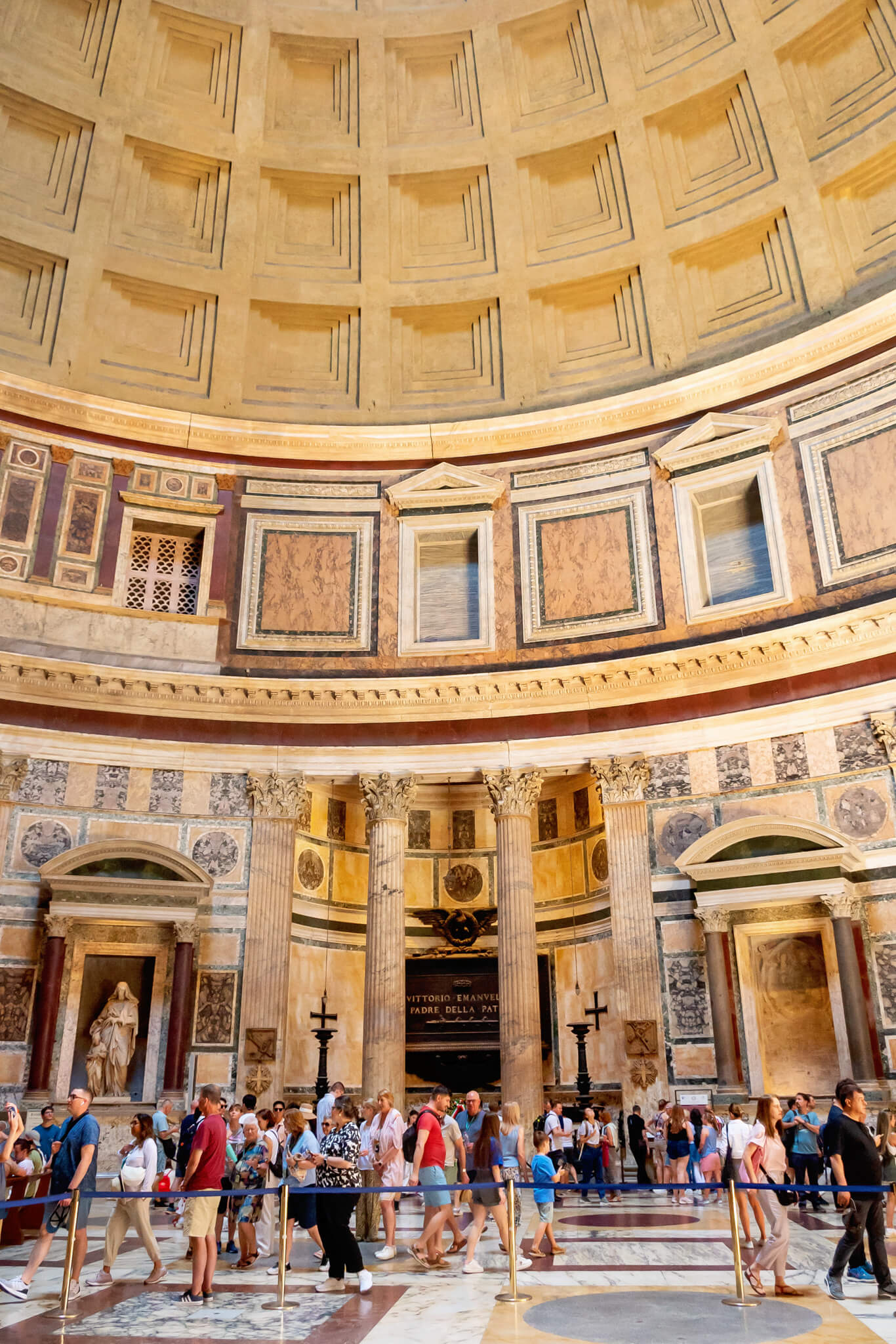
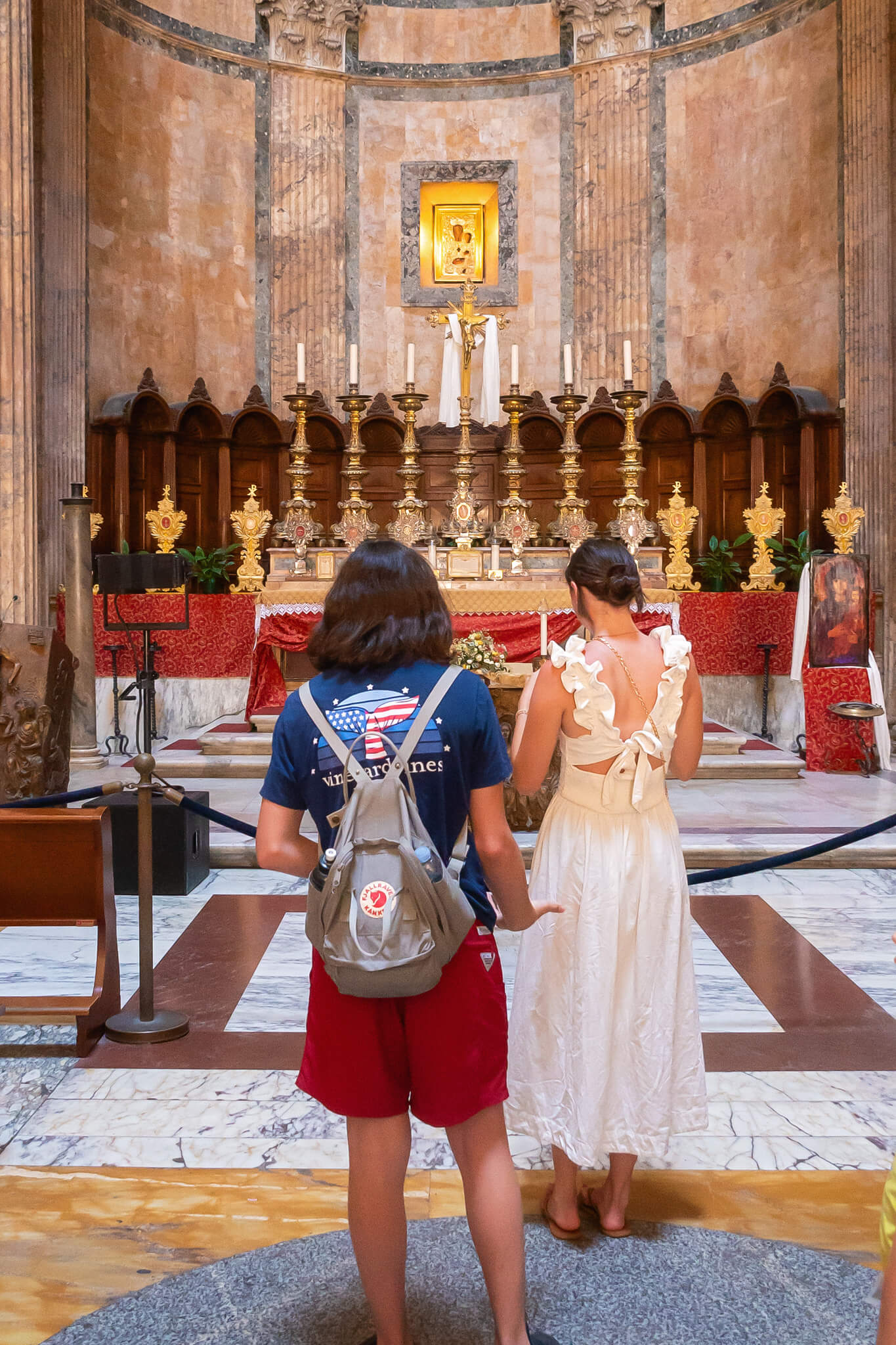

Getting to the Pantheon
It’s easy to reach on foot from popular tourist neighborhoods like Centro Storico, Trastevere, and Piazza Navona. We stayed in Trastevere, across the Tiber River, and it was about a 15-minute walk. Other neighborhoods are even closer. The Pantheon is located in the Pigna neighborhood. This area has many hotels and lodging options available and is known for its blend of ancient and contemporary culture.
The Pantheon is located in a part of the city closed to traffic, so if you take a taxi or Uber, they will get you close (about a minute away), but not right at the doorstep of the Pantheon. Taxis will typically drop you off at the back of the Pantheon on Piazza della Minerva when visiting the Pantheon.
If your lodging isn’t nearby, and you think you can navigate public transport, you may want to consider taking a bus to the Pantheon. The closest bus stops are at Via del Corso, Piazza Venezia, and Largo di Torre Argentina, which will bring you very close to the Pantheon.
Also, if you have purchased tickets to the Rome Hop-on, Hop-off Bus, it will take you pretty close. Depending on the line you are on, the closest stop is Via del Corso / Piazza Venezia / Largo di Torre Argentina.
Piazza della Rotonda
The Piazza della Rotonda, the square where the Pantheon is located, is lined with charming restaurants and gelato shops. We stopped at a restaurant there for drinks at an outside table and were seated literally 100 feet from the Pantheon. Talk about an amazing memory!
The Piazza della Rotonda is a fun place to shop, dine, and experience the local vibe while visiting the Pantheon. Unfortunately, there are a ton of vendors walking around selling phone chargers, flowers, toys, and water, which detracts from the area’s magic. As with any busy place in Rome, keep your phone and wallet in a safe, discreet place away from pickpocketers. I like to wear a crossbody bag and keep it on while sitting at restaurants.
I will note that when we were there in June 2024, the Fontana del Pantheon at the center of the square was boarded off for restoration. We noticed that many of the fountains in Rome were also closed off. We were told that it was in preparation for the Jubilee Holy Year in 2025.
Best Times To Visit The Pantheon
The best times to visit the Pantheon are during off-peak hours, like early morning and later in the day, near closing. The Pantheon is a top tourist attraction in Rome, so expect it to be crowded.
We visited the Pantheon twice, once in the morning and once right before closing, and both times, there was a short (less than a minute) line. I’ve heard that during peak times, the lines can be long. Special events like mass or religious holidays can increase traffic or modify visitation hours. Catholic mass is held every Sunday at 10:30 AM and on Saturdays at 5 PM and is open to the public.
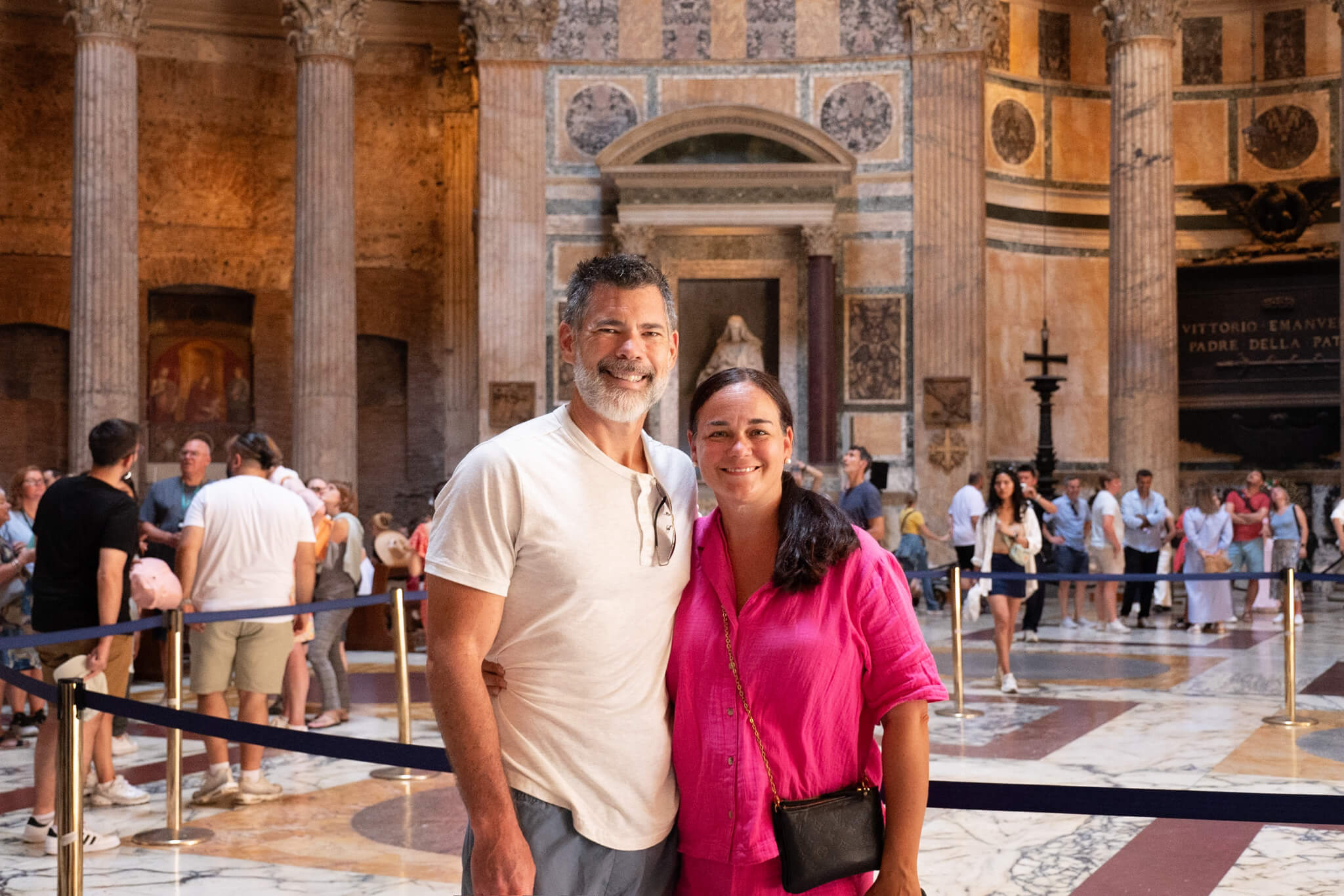

Buying Tickets For The Pantheon
To enter the Pantheon, you must have tickets. They are 5 euros each for adults and can be purchased at the official Pantheon Website or in person at the ticket office. The third option is to buy online at the Pantheon using a QR code that can be scanned by phone (which takes you to the official website).
We decided to wait to book tickets in order to have more flexibility as they don’t typically sell out like at other places. We arrived at the Pantheon later in the day, and the ticket office was closed. Once there, we tried using the official website to purchase tickets, but it was challenging. One reason was the spotty cellular service in the area. The second reason was that the website required you to go through several validation steps, and the payment processing was not functioning. We couldn’t pay for the tickets or complete the checkout process. I have read that other people have the same problem, and of their credit cards being declined.
The whole situation was very chaotic, and we gave up on visiting the Pantheon that day after about 10 minutes. For this reason, you may want to consider purchasing the tickets through Get Your Guide, which is what we did. Their website/app has a streamlined, easy payment process and accepts many forms of payment. The only downside of buying tickets through Get Your Guide is that you will need to meet with a representative near the Pantheon at a set time to collect your physical tickets. But this extra step was right on the way and well worth it for us the see this amazing building. Plus, it was basically the same price.
We recommend getting these tickets: Pantheon Skip-the-Line Entry Ticket.
Pantheon Guided Tours or Audio Guides
We always enjoy guided or audio-guided tours of locations like the Pantheon. These tours give you a wealth of information about the Pantheon’s history, design, artwork, and cultural impact from antiquity to today. So, consider adding on a tour while visiting the Pantheon.
The highest-rated guided tour is the Pantheon Small-Group Guided Tour with Entry Ticket, with a 4.9 rating. The Pantheon Fast-Track Ticket and Official Audio Guide are great options for an audio-only tour. Both of these tours include fast-track entry tickets.
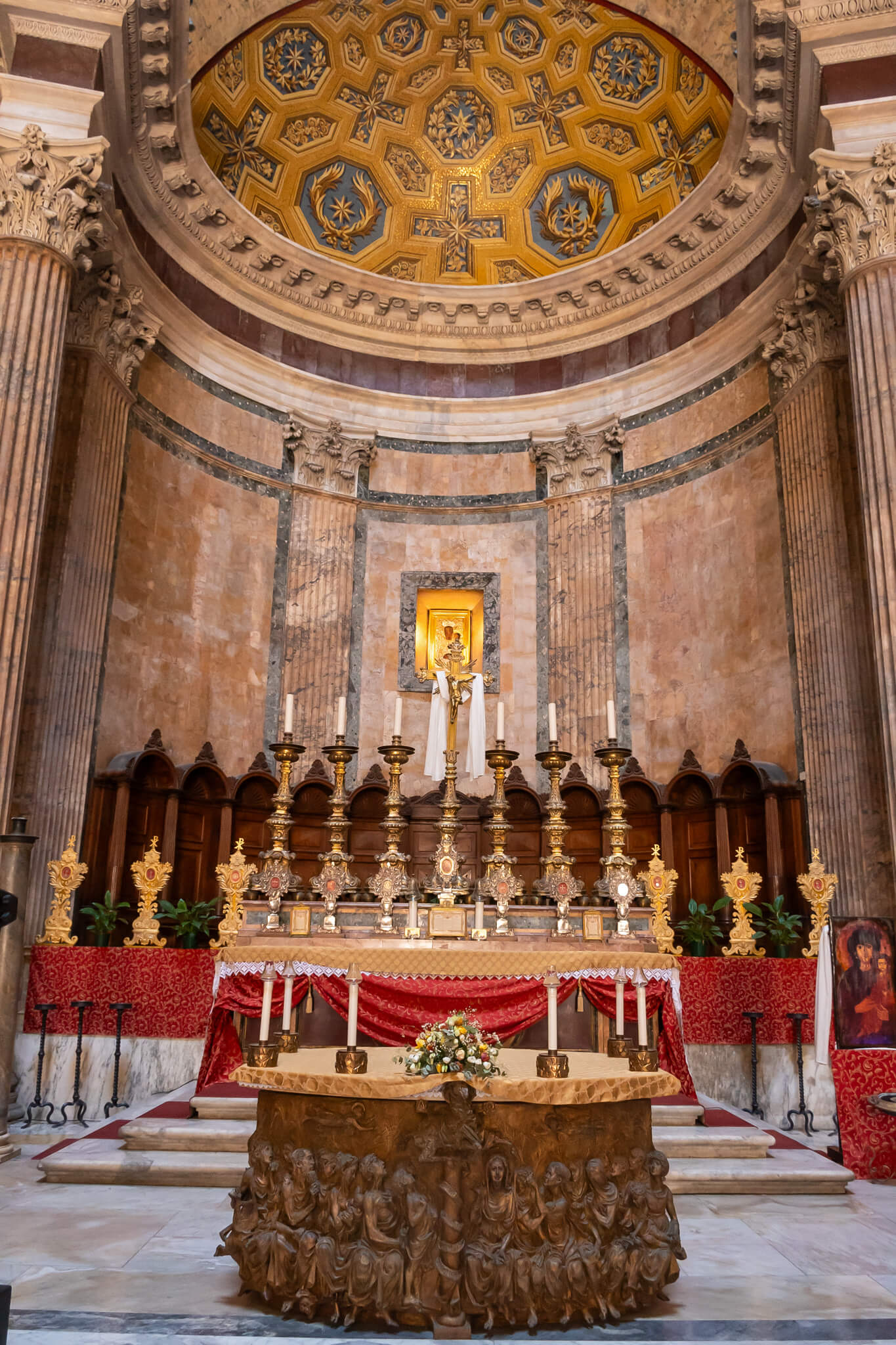
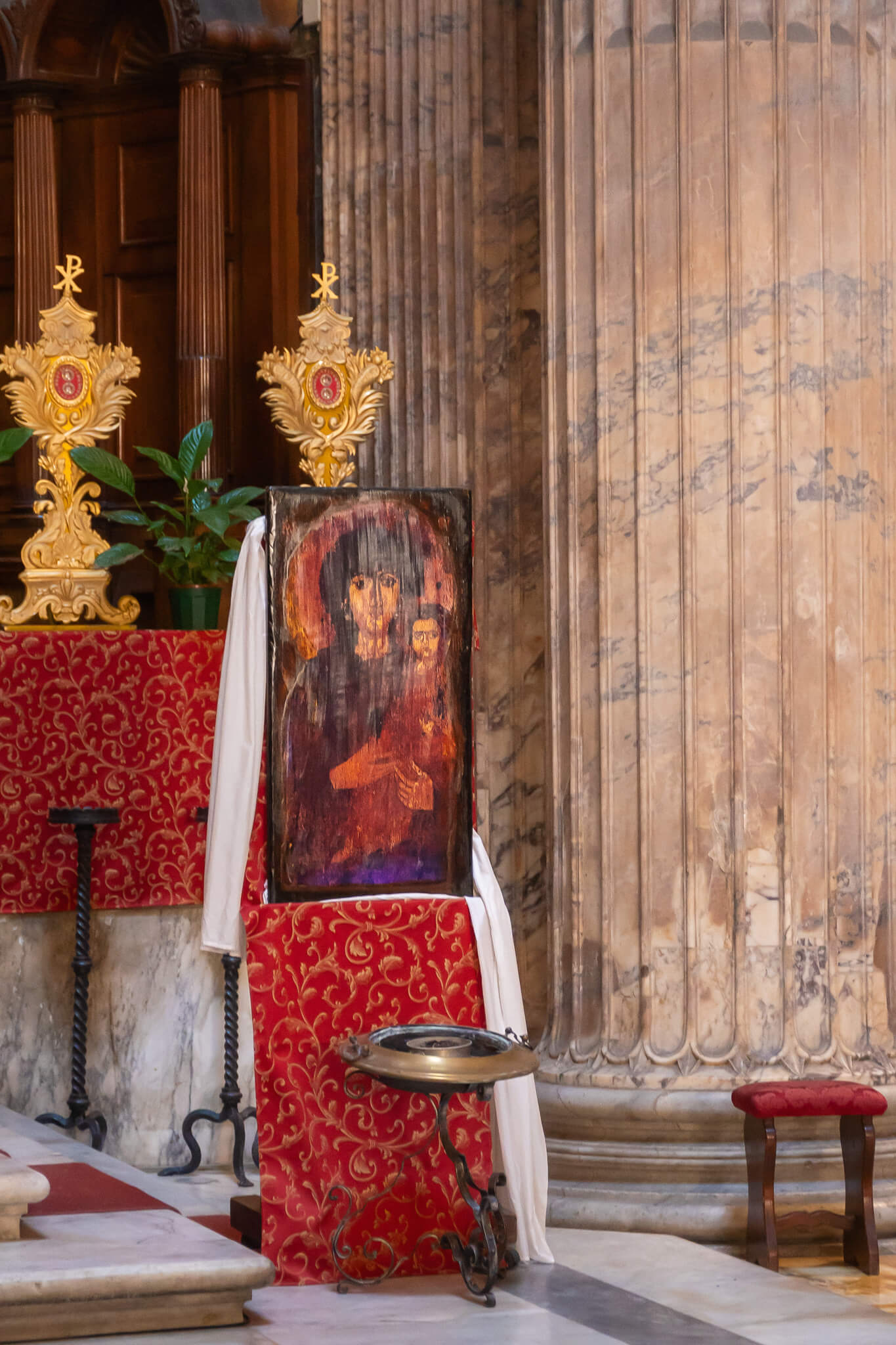
Pantheon Hours
Pantheon Opening Hours: 9 AM to 7 PM (last entry 6:30 PM)
Closed on: 1st January, 1st May and the 25th December
Access to the Pantheon is free on the first Sunday of each month
Tips For Visiting The Pantheon
Here are a few tips you may find helpful in planning your trip to the Pantheon. Many of these are things we wish we had known prior to the visit so we could have planned accordingly. We were also in and out in under an hour, so this is a great shorter activity to fit in while exploring the city.
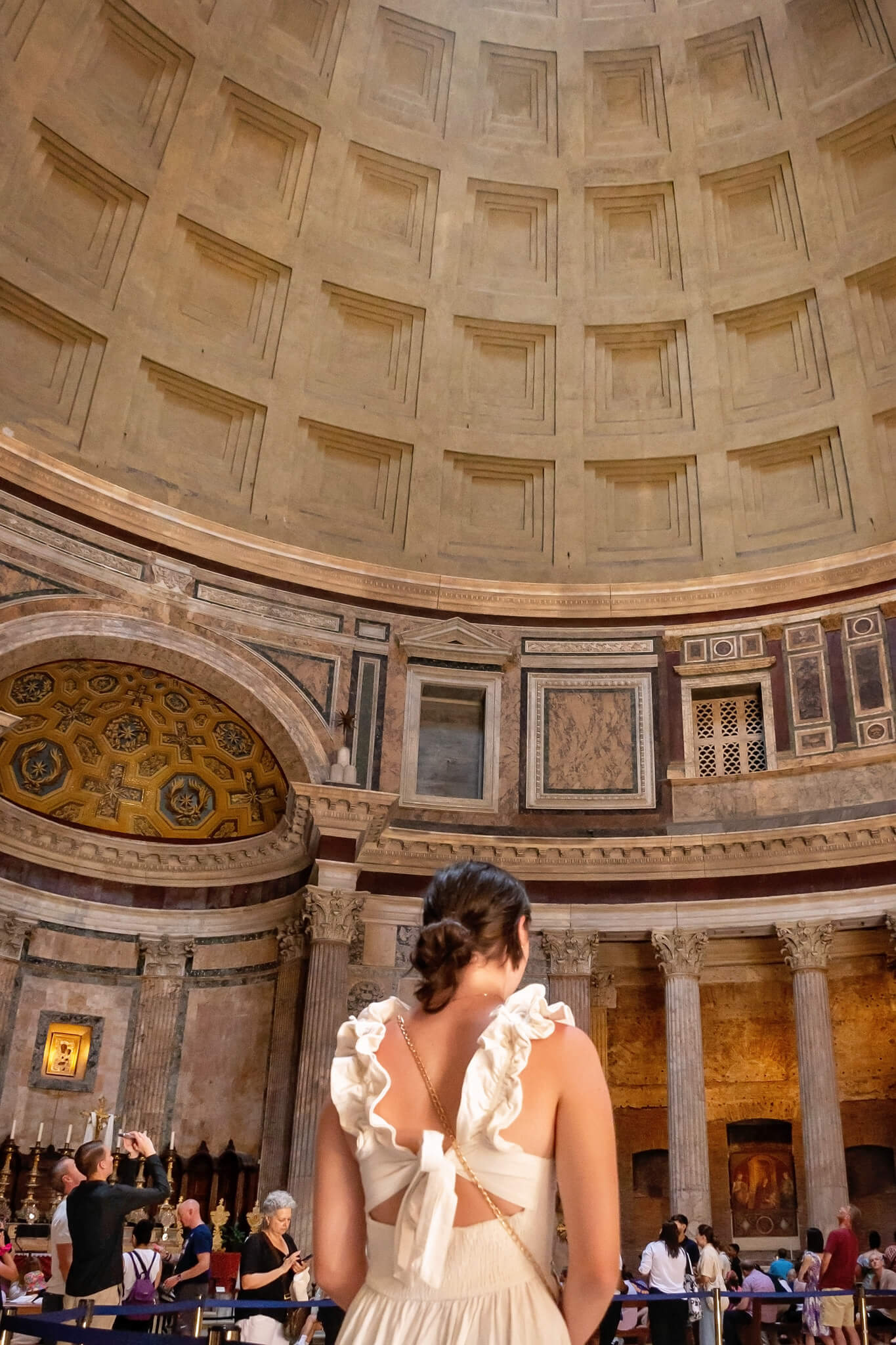
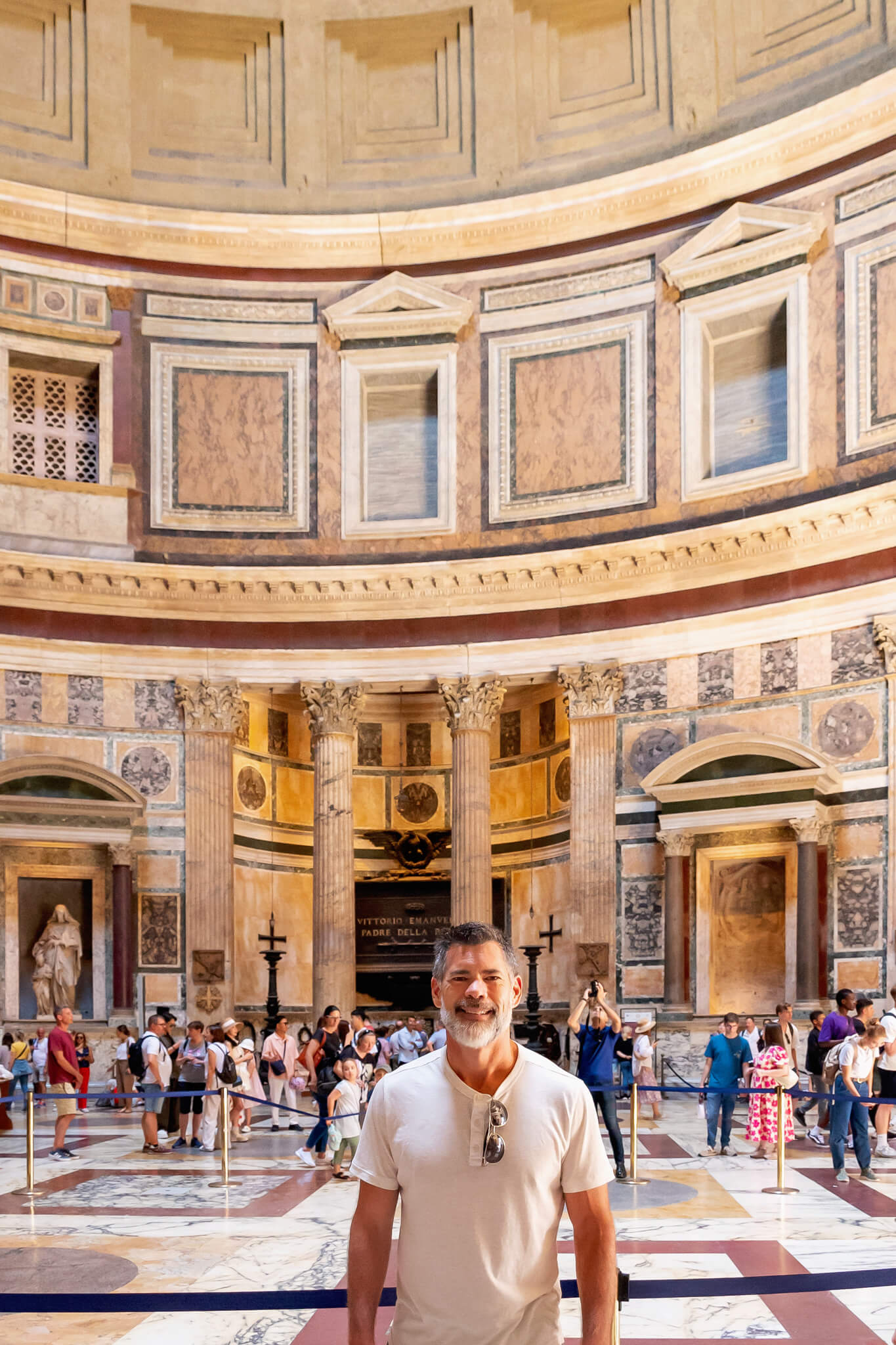
Photography Tips
The Pantheon is a photographer’s dream, with lofty spaces, gorgeous artwork, and beautiful light filtering in through the eye (oculus) at the apex of its impossibly large dome.
The iconic shot is a selfie with your head framed by the oculus just before or after noon. The sun projects a shaft of light through the oculus and into the darkness of the dome, creating a magical effect of divine light illuminating empty space. The rich contrast of light and darkness provides many opportunities for creative photography, overlaying elements of the real with the surreal.
I took so many photos at the Pantheon, and the lighting is great on a sunny day when the daylight streams in through the center of the dome.
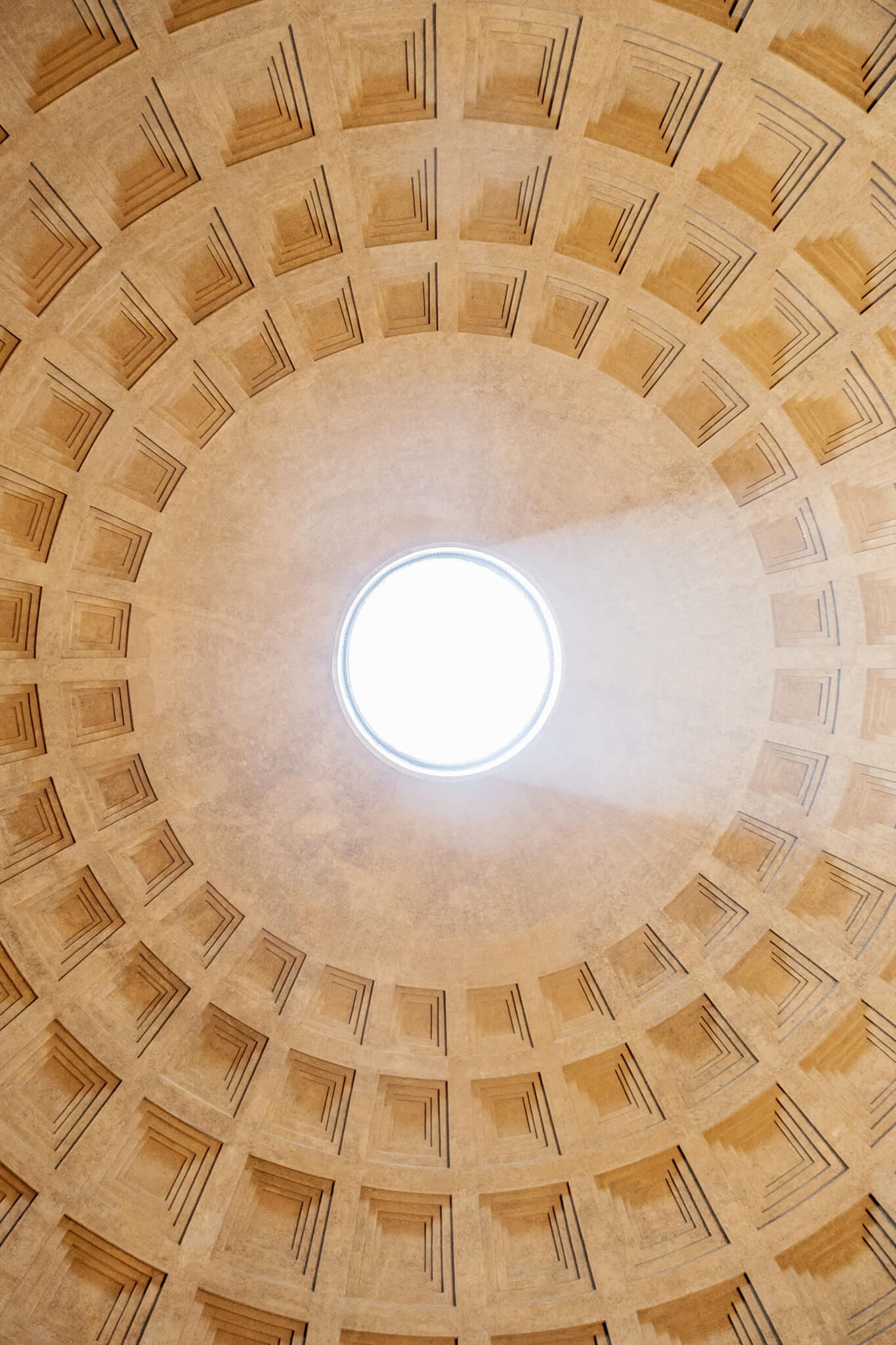

Pantheon Dress Code
The Pantheon is a Catholic Church, and modest attire is required to enter. This dress code applies to all Catholic churches and Holy sites in Rome.
During our visit, we found that this rule is not strictly enforced. Still, blatant violations could be grounds for being denied entry. Do not wear very short skirts or mini skirts. These are deemed too revealing. Longer skirts (below the knee) and linen trousers are better options. Cover your shoulders, and don’t expose your belly or cleavage.
If you are uncertain, bring a shawl to cover your shoulders. Shorts are allowed (unlike at the Vatican). Sandals and flip-flops are usually fine to wear (even though signs at some churches say no open-toed shoes.) Small children are generally not subject to these rules.
What To Bring
If you visit Rome in the summer, the temperatures will get hot. During our trip, we had several days in the high 80s. Be sure to dress appropriately (bearing in mind the dress code discussed above) and plan your day around your family’s needs, the distance between sights, and the weather. I recommend the following when visiting the Pantheon:
Comfortable Shoes: You will likely be walking in the surrounding areas, so consider sneakers over sandals or flip-flops.
Water: Bring one or two water bottles. Luckily, Rome has many free potable water fountains throughout the city, where you can refill them.
Sunscreen: Especially in summer, the sun can be intense when walking around Rome.
RELATED POST: Top 10 Tips For International Travel
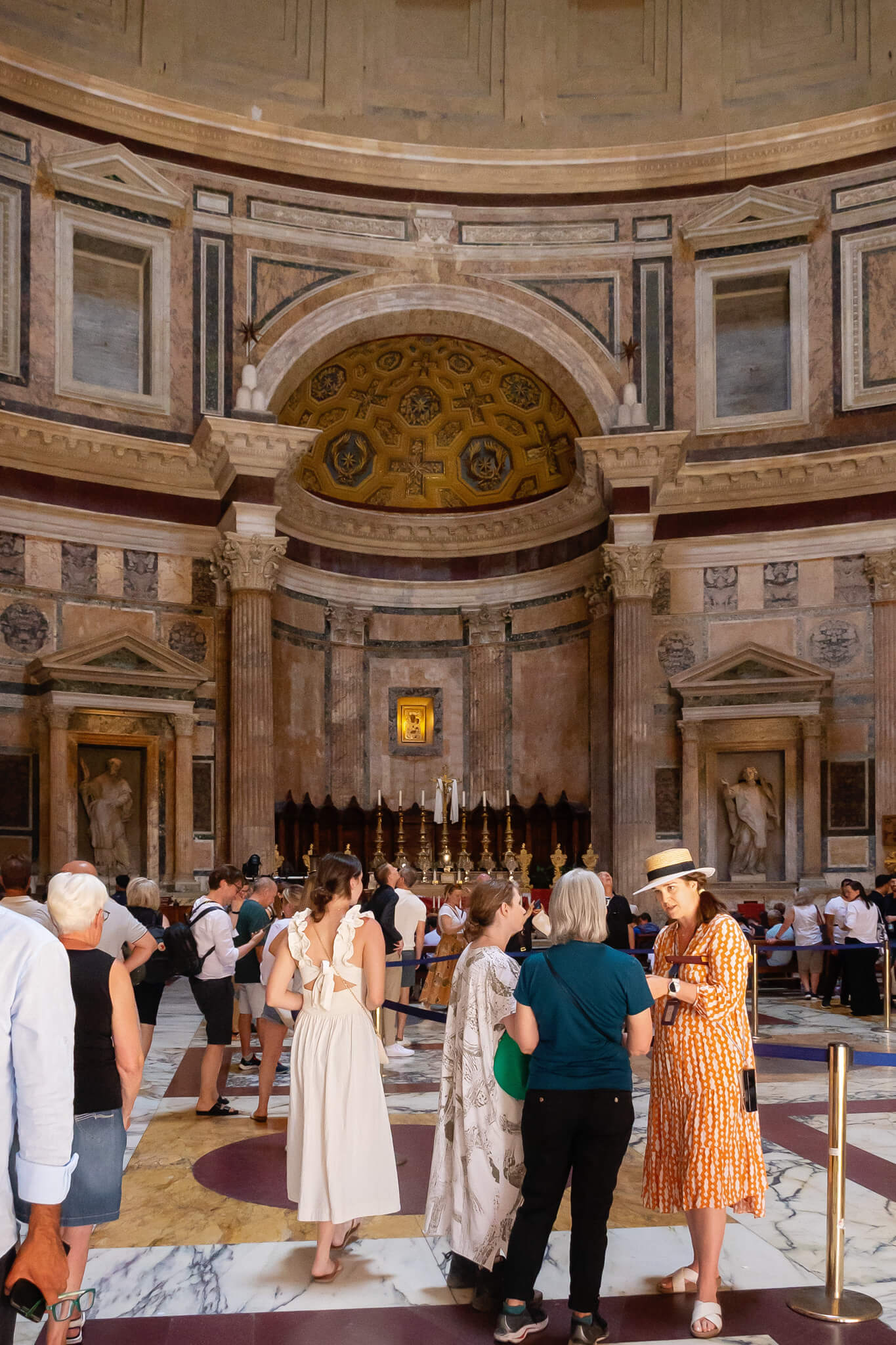
History of the Pantheon Rome
The Pantheon was originally commissioned by Marcus Agrippa during the reign of Augustus (27 BC – 14 AD). Agrippa, a close friend and general of Augustus, constructed the Pantheon as a temple dedicated to all the Roman gods.
The inscription on the Pantheon entrance, “M·AGRIPPA·L·F·COS·TERTIVM·FECIT” reads: “Marcus Agrippa, son of Lucius, built this during his third consulate.”
A fire damaged the original Pantheon. It was later reconstructed by Emperor Hadrian around 126 AD. Hadrian restored Aprippa’s original inscription to honor his predecessor.
In 609 AD, the Byzantine Emperor Phocas gave the Pantheon to Pope Boniface IV, who consecrated it as the Church of St. Mary and the Martyrs. This transformation from a pagan temple to a Christian church helped ensure the building’s preservation through the centuries, protecting it from the neglect and destruction that befell many other ancient Roman structures.
During the Renaissance, interest in the Pantheon was renewed. It became a designated burial place for notable figures, including the painter Raphael and several Italian kings. The Pantheon’s architectural principles also greatly influenced Renaissance architecture, with its harmonious proportions and innovative use of space inspiring architects like Brunelleschi and Michelangelo.
In modern times, the Rome Pantheon remains a functioning church. Church services and special religious events are still held regularly.
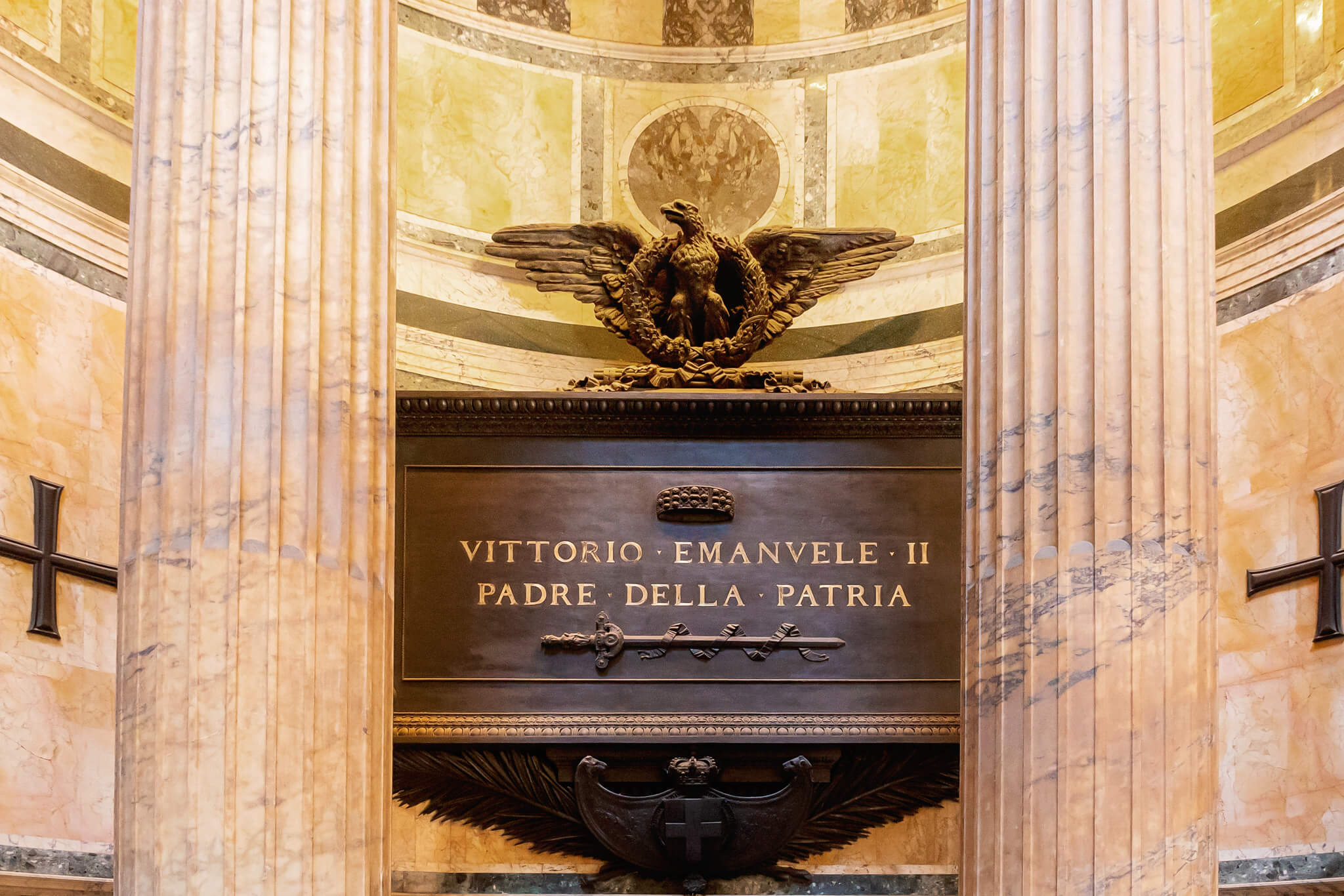
Architectural Features of the Pantheon, Rome
The Pantheon’s design is a masterpiece of Roman engineering and architectural ingenuity. The building features a rectangular portico with massive Corinthian columns made of Egyptian granite, leading into a cylindrical rotunda topped by a huge, coffered concrete dome.
The dome, which remains the world’s largest unreinforced concrete dome, has a 27-foot wide oculus at its center. This circular opening lets in natural light and serves as a symbolic connection between the temple and the heavens.
The interior of the Pantheon has several niches, or shrines and tombs, that contain gorgeous paintings, frescoes, and sculptures. In the third niche lies the “bones and ashes” of painter and architect Raphael, who, along with Leonardo da Vinci and Michelangelo, formed the trinity of great masters during the High Renaissance. Rahpel’s burial site is one of the most popular shrines within the Pantheon.
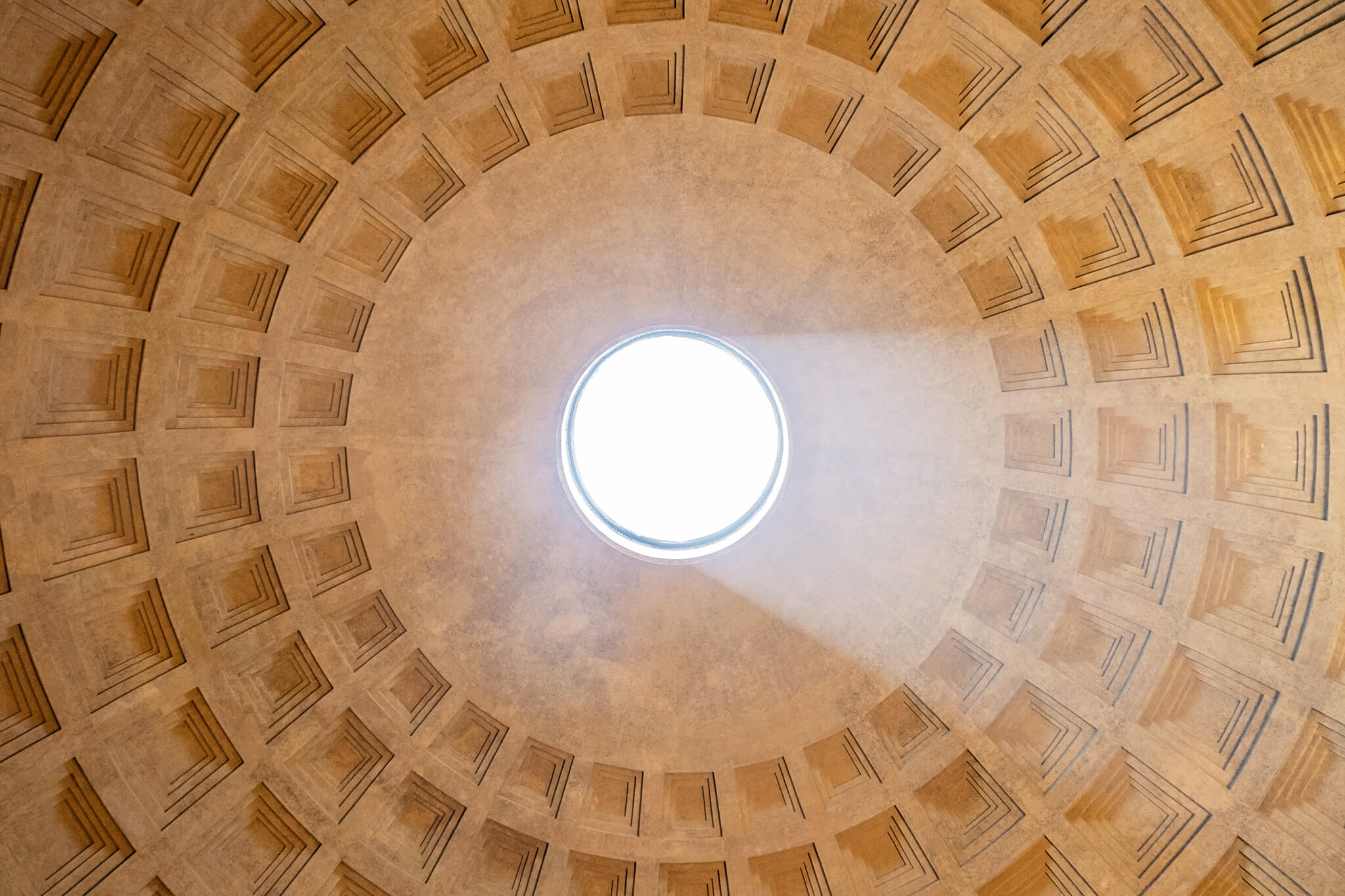
Add The Pantheon To Your Rome Itinerary
The Pantheon is a fantastic destination to include in your Rome itinerary. It’s relatively inexpensive and accessible for travelers of all ages and capabilities. Furthermore, its location in the heart of the city makes it conveniently located near other sights like the Trevi Fountain or the Spanish Steps.
I know you’ll enjoy immersing yourself in the long history of the place, marveling at its stunning achievements, and ending your visit with some gelato or a cool drink on the plaza.
You May Enjoy These Other European Travel Posts
If you enjoyed hearing about our Pantheon visit, you’ll enjoy the rest of our European travel content. In the past two years, our family has visited France, Belgium, the Netherlands, England, Greece, Italy, Austria, and Germany! I pride myself on sharing valuable firsthand knowledge and my own photographs on my blog, all alongside valuable family travel tips and travel inspiration!
- Paris 4-Day Itinerary
- Is The Mona Lisa Overrated?
- Amsterdam Canal Tours
- A Day Trip to Bruges
- Ancient Roman Baths in Bath, UK
- Top Historical Sites in Athens
PIN: Visiting the Pantheon in Rome
